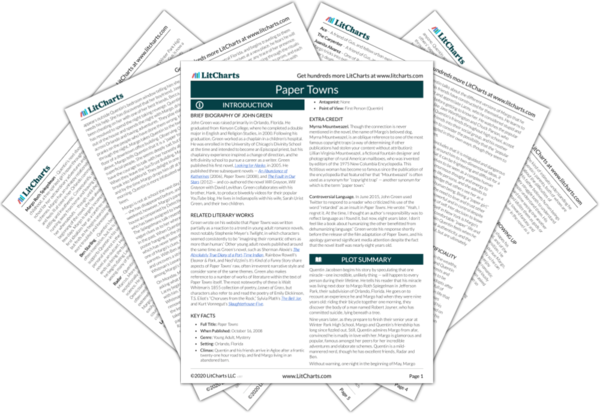Quentin claims, at the beginning of the novel, that he has been in love with Margo since they were children. Though their friendship has fizzled over the years, he is amazed by the rumors he hears about Margo’s adventures: her solo road trip through Mississippi, her three days traveling with the circus, and similar, larger-than-life escapades. He thinks of her as the perfect girl, both beautiful and intriguing. As his investigation of her disappearance develops, however, Quentin comes to understand that Margo is actually a deeply sad and lonely person, who is surrounded by admirers but has no close, trusted friends. As his perception of Margo changes, Quentin stops thinking of her disappearance as an exciting mystery, and begins working to understand her pain. This project helps Quentin to become more compassionate in other aspects of his life, and he grows kinder and more generous toward the people around him as his story develops. Eventually, however, he must confront the possibility that he may never be able to fully understand another person, and that some emotions and motivations must always remain a mystery to him.
His friends and classmates are guilty of similar oversimplifications, not only of Margo, but of one another. Quentin talks about the different versions of Margo that he and his friends have constructed for themselves. He learns to respect and appreciate Lacey, who he considered stupid and shallow before getting to know her. He watches the popular students like Jase Worthington and Chuck Parson, who tormented Quentin’s friends throughout high school, accept those same friends into their social group, and his mother encourages him to consider the possibility that the “popular kids” have struggled in their own ways, though they seem to lead charmed lives.
Though Quentin concludes that it is misguided and dangerous to reduce the people around him to two-dimensional ideas, it also becomes clear that it can be frightening and difficult for a person to allow themselves to be seen as a complex human being. Margo dedicates enormous thought and energy to cultivating her larger-than-life persona, and she admits to taking pleasure in the knowledge that others see her as a beautiful idea, rather than a human being. Being a “paper girl,” as she calls it, frees her from the need to love and trust other people, and allows her to feel powerful and in control despite her unhappiness and shaky sense of self. Her decision to leave Orlando and make a home for herself in New York is Margo’s attempt to push herself out of that comfortable “paper” life and toward a greater authenticity. The pain Quentin feels when he and Margo part ways is a reminder that authenticity, and the intimacy it creates, can be deeply painful, but are ultimately necessary to living a full, real life.
Perception vs. Reality ThemeTracker

Perception vs. Reality Quotes in Paper Towns
Even though I could see her there, I felt entirely alone among these big and empty buildings, like I’d survived the apocalypse and the world had been given to me, this whole and amazing and endless world, mine for the exploring.
[M]aybe Margo needed to see my confidence. Maybe this time she wanted to be found, and to be found by me. Maybe — just as she had chosen me on the longest night, she had chosen be again. And maybe untold riches awaited he who found her.
I refused to feel any kind of sadness over the fact that I wasn’t going to prom, but I had — stupidly, embarrassingly — thought of finding Margo, and getting her to come home with me just in time for prom, like late on Saturday night, and we’d walk into the Hilton ballroom wearing jeans and ratty T-shirts, and we be just in time for the last dance, and we’d dance while everyone pointed at us and marveled at the return of Margo, and then we’d fox-trot the hell out of there and go get ice cream at Friendly’s.
Standing before this building, I learn something about fear. I learn that it is not the idle fantasies of someone who maybe wants something important to happen to him, even if the important thing is horrible … This fear is bears no analogy to any fear I knew before. This is the basest of all possible emotions, the feeling that was with us before we existed, before this building existed, before the earth existed. This is the fear that made fish crawl onto dry land and evolve lungs, the fear that teaches us to run, the fear that makes us bury our dead.
“I know it’s impossible for you to see peers this way, but when you’re older, you’ll start to see them — the bad kids and the good kids and all kids — as people. They’re just people, who deserve to be cared for. Varying degrees of sick, varying degrees of neurotic, varying degrees of self-actualized.”
“The longer I do my job … the more I realize that humans lack good mirrors. It’s so hard for anyone to show us how we look, and so hard for us to show anyone who we feel.”
The fundamental mistake I had always made — and that she had, in fairness, always led me to make — was this: Margo was not a miracle. She was not an adventure. She was not a fine and precious thing. She was a girl.
“Oh bullshit. You didn’t come here to make sure I was okay. You came here because you wanted to save poor little Margo from her troubled little self, so that I would be oh-so-thankful to my knight in shining armor that I would strip my clothes off and beg you to ravage my body.”
















